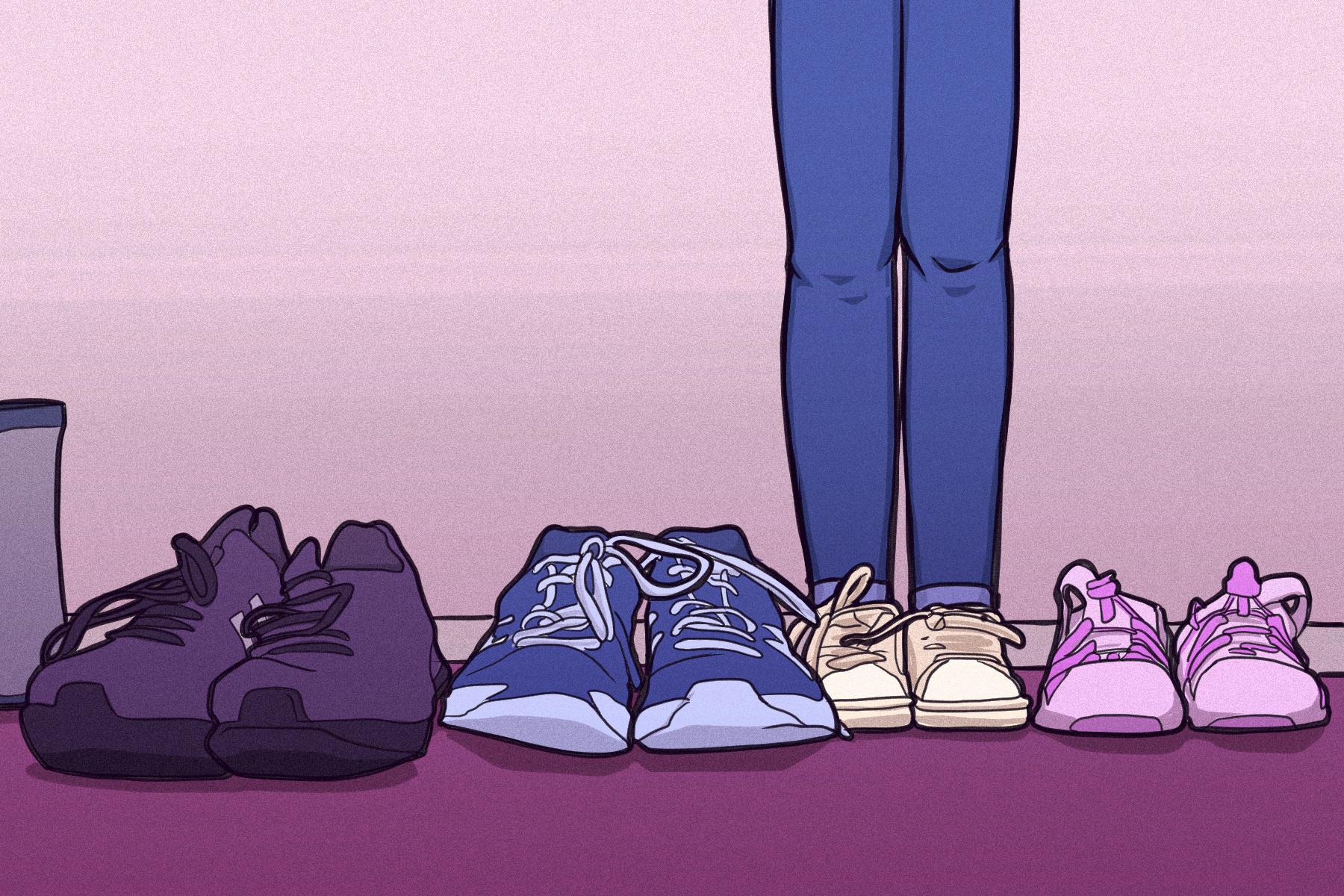Do you ever think about how strange and particular your everyday habits are? Not the routines you save for special occasions and the like; rather, the nitty-gritty rituals that help you get out of, and back into your bed each day. Some like to journal, others are fond of podcasts, and some don’t even think about the mundane little steps it takes to make it all possible. Whatever your conscious and unconscious habits, they will tell a story about the way you live your life and even where you come from. Notably, the resurgence of an internet-favorite debate reminds us that the trivial question of where one should wear shoes can be laced with some culture-shattering truths about habits.
In short, the “wearing shoes in the house” debate is as simple as it sounds: Should a person wear shoes in their house, or take them off once stepping inside? Such a question eventually spirals into hesitations over taking one’s shoes off in another’s home, and the sticky implications that come with assuming the customs of the host. The addition of a cultural element also carries weight in the shoe debate, seen across cultures where removing or leaving shoes on can hedge into territories of disrespect. All shoe-filled questions aside, the back-and-forth nature of this debate resurges with each newly published piece on the matter. Scary Mommy’s recent article titled, “Scientists have entered into the ‘No Shoes Inside’ debate,” was clearly a research-filled addition to a history-heavy ordeal.
What makes Sarah Aswell’s Scary Mommy article less fearful is its support from scientific evidence. Beyond why you should simply “leave your disgusting shoes at the door, for your health,” the author’s validity pulls from the team behind DustSafe, which has conducted decades-long studies of dust and debris. Their extensive research into the dust that resides in our homes concluded that how we step out has a great deal to do with what we breathe in. Examining the dirt in your vacuum cleaner, the scientists at DustSafe revealed, “a lot of harmful stuff can come tromping through the door on your sneaks,” as Aswell put it.
Everything from bacteria to dirt, microorganisms and even lawn chemicals can stick to your shoes and travel home with you. The fact that you’re essentially inhaling the elements that you track into your space makes a person question how healthy it is to sport your kicks at home. Plus, with the only benefit to wearing house shoes being a more comfortable stroll up and down the hallway, it’s difficult to see why there is any debate at all.
Surprisingly, the author also recalled how “shoes didn’t cross the welcome mat” in her own home, based on cultural values from her Korean father. While the irony of mentioning her father on Scary Mommy certainly induces a little chuckle, Aswell raises a subtle question about cultural considerations: Not only is the shoes-or-no-shoes conversation an older debate but the tensions behind it are aged from the cultural weight. Varied cultures and rich practices around the world have influenced personal opinions on entering a person’s personal stomping grounds with shoes or without. For example, Scary Mommy’s shut-down of shoes indoors is written from an American perspective on the matter, dually influenced by scientific research and her own Asian household traditions. Considering the fact that stereotypes assume all Americans wear shoes in the house, the article resonated with other groups who wanted to weigh in on the debate with their habitual experiences.
Twitter’s comment commotion on Scary Mommy’s article glimpsed into diverse and culturally opinionated voices on the matter. One user proudly stated, “Canadians remove their shoes when entering the house. It’s considered very rude to enter someone’s home here and keep your shoes on.” The key word in this comment is the use of “here”: While the commenter revealed his own opinion on wearing shoes in the house, he inadvertently showed that it is directly tied to the local culture. Instead of Scary Mommy’s hybrid conclusion that used science and culture, the Canadian user proved that one’s footwear habits can be solely culture-based. Another user punched out a brief remark: “Brazilians don’t do that, here we walk in slippers inside and outside the house and the shoes we take off only on the carpet or sofa.”
Contrary to the Canadian comment, the nod from Brazil exposed new conditions that may determine whether one wears shoes indoors or not. While both comments shared what they believe are the practical “norms” of habit, nobody identified the opinionated nature of the comments better than the following tweet: “In Portugal, when a guest enters a home without removing their shoes at the doorstep, it is considered a sign of disrespect to host. Interesting how cultures have different customs.” Complete with a smiley face emoticon, the comment from Portugal shifts the perspective away from heavily biased bickering about who practiced “better” shoe-wearing habits, to celebrating these comments as indicators of cultural differences.
Regardless of the ways that the Scary Mommy article supports their position with on-the-nose research, the act of wearing or removing footwear is staunchly tied to these cultural roots. Some Asian and European households see removing shoes as the norm when entering a home, while others, like U.S.-based homes, parse through the practicality of the act. Then perhaps the American article from Scary Mommy just seems “revolutionary” in the eyes of locals; generally speaking, the thought of removing one’s shoes before entering an American household seems foreign.
Mom-bloggers from 2011 and Today articles from 2018 have all weighed in on why wearing shoes in the house is less than ideal, and yet it is still common to watch American households refuse to leave their shoes at the door. Without negating the fact that this is a mere generalization, the multicultural commentary that weighs in on Scary Mommy’s article exposes a divide in customs, for the benefit of personal comforts. However, casting a blanket generalization that all Americans wear shoes in the house, or all Canadians or Brazilians do not, can only be successful with consideration of these cultural bounds.
As an example of stepping out in a controversial direction, a very vibrant article titled “Here’s Why I’ll Be Keeping My Shoes on in Your Shoeless Home” was published by The Wall Street Journal this past February. After all, with a tagline like, “Why are you assuming that your guests’ shoes are dirtier than your floors?” the punchy statement is bound to leave no sympathy in its path. Author Kris Frieswick unspooled her position on the shoe debate by excusing the cultural and religious reasons why people would ask her to remove her footwear, and instead targeted the “cleanliness” of it all. To quote from the WSJ article, the author noted that “barring shoes outright just to keep your floors clean is bringing a gun to a pillow fight.” A series of remarks by the author framed hosts as “forcing” her to conform to a set of rules she doesn’t feel like following, for fear of making her feet vulnerable to unfamiliar territory. To sum it up, Frieswick established a firm footing and said that she would wear her shoes regardless of the host’s requests, taking offense to the assumptions about her “dirty” feet.
It seemed as if Frieswick’s attempt at relatability fell flat on the floor, as hordes of people came out to berate the article. Most notable was The Guardian’s response to Frieswick’s position on footwear favored home visits. Wrapping the article with a satirically similar title, “Here’s why your shoes will be staying the hell out of my house,” The Guardian fleshes out “the basic arrogance of rejecting the customs” of a host’s house, something that Frieswick actively ignores in her rant. Additional Reddit users also went wild with responses to the WSJ article. Most users reflected on the somewhat tone-deaf voice of Frieswick, noting that her responses to the shoe debate sounded like an entitled guest. What the back-and-forth conversation revealed about whether to wear or not to wear shoes in the house, is that it is an intensely personal position borne out of underlying traditions. Passionate proponents of leaving their shoes at the door, and those who freely tromp in and outdoors all the same, both reflect how the habits of the individual create what they value the most.
Every single opinion embedded in the Reddit ruckus, The Guardian and even the Wall Street Journal, is simply from people like the aforementioned Twitter users: individuals who choose to share their cultural opinion in the multicultural space of the web. The easiest workaround for such a situation as this is realizing and respecting these different habits as true to the people who abide by them, with no rhyme or reason. But if questions of footwear formalities in someone’s home send you in a tizzy, then maybe the best course of action is to respect the wishes of the host. After all, they are the ones so graciously offering you access to their space.
At the end of the day, the succinct words of Aswell’s internet-hit shoe conclusion say it best: “While you can’t stop all of that crap from getting into your house, taking off your shoes helps.” If a site called “Scary Mommy” is telling you, the reader, to be cautious of the “crap” coming through your front door on your shoes, then it might be time to consider the comment. There’s nothing wrong with amending an old habit and trying something new — if anything, it’s a sign that there’s a more convenient way to carry out your everyday routines, with benefits to boot. You might even like what happens when you step in another’s shoes for a spell.

















